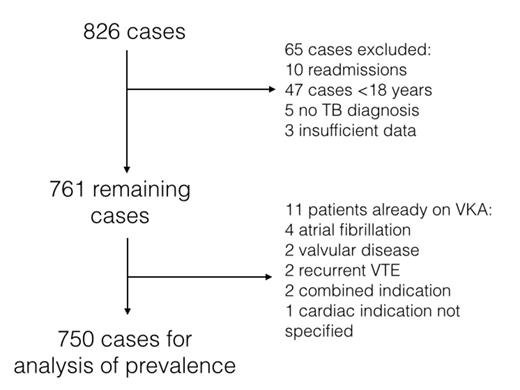Abstract
Introduction
Tuberculosis (TB) claims over 1 million deaths per year. Some patients die despite institution of effective chemotherapy. As epidemiological and fundamental research show that acute or chronic inflammatory diseases are a risk factor for thrombotic events, TB-patients may especially be at high risk for venous thrombotic events (VTE) as TB is an infectious disease that can be seen as an acute-on-chronic inflammatory process and is often associated with a double/triple infectious burden caused by HIV or hepatitis. Consequently, VTE may explain a part of TB related mortality, which may in turn be preventable through institution of thromboprophylaxis. We therefore set out to explore the burden of thrombotic disease in a cohort of TB patients.
Setting
Beatrixoord TB Center, Groningen, the Netherlands, is a multidisciplinary referral Center for complicated TB. The case mix of TB patients mostly comprises patients that have a relatively stable somatic condition but need inpatient care because of socio-psychological factors, but also patients who have severe debilitating infectious disease with comorbidities requiring long term inpatient care are admitted.
Methods
In this retrospective cohort study, we reviewed all charts of cases discharged (alive or deceased) with a first admission to the center in the years 2000 through 2010. Cases were defined as suspected and treated or confirmed infection with Mycobacterium tuberculosis complex. We excluded cases younger than 18 years and those already on therapeutic anticoagulant therapy. Primary outcome was VTE, with no restriction on localization. A VTE was defined as confirmed if relevant imaging was done or if VTE-related anticoagulant therapy was administered for at least 3 months. We assumed VTEs were related to TB if they occurred in the six months before institution of anti-tuberculosis therapy until discharge. We recorded date of diagnosis and relevant exposure (up to six weeks before VTE) to classic risk factors (surgery, pregnancy, malignancy and immobilization) and hospitalization. For patients without an event, we noted any exposure to classic risk factors and hospitalization. Patients were defined as hospitalized if they had been admitted to a hospital elsewhere. Patients were defined as immobilized if they had a plaster cast on/fracture/paralysis of any extremity or if they had been clearly bedridden for >7 days.
Results
750 patients were included for the analysis of incidence of VTE (figure 1).
Eighteen patients had a VTE according to our definition, 17 of these were diagnosed before admission to the clinic. Three VTEs were unprovoked. One patient died in circumstances highly suspicious of pulmonary embolism but autopsy was not performed. Consequently, we excluded this case from our analysis. Patients with an HIV co-infection or disseminated TB had the highest risk of VTE (odds ratio 11.2 95%CI [4.3-29.2] and 3.3 [1.3-8.8] respectively, compared to patients without these risk factors). Other characteristics are presented in table 1.
Discussion:
In this cohort of TB patients, 2.4% of patients had a VTE. The majority of VTEs had a provoking factor. However, there was still an event rate of 1% in patients not exposed to classic risk factors/hospitalization. This seems higher than an expected incidence of 0.1%. Patients with a HIV co-infection or disseminated TB had the highest risk of developing a VTE. This may warrant the use of primary prophylaxis in these patients. Our findings may be an overestimation of the true incidence as our clinic is a tertiary center. However, social (and not medical) complexity was the most common reason for referral. Nonetheless, these results need confirmation.
VTE rates stratified by clinical characteristics & univariate analysis
| VTE: N=18 . | Odds of VTE in risk factor positive cases (%) . | Odds of VTE in risk factor negative cases (%) . | Odds ratio (95%CI) . | |
|---|---|---|---|---|
| Male sex | 16/522 (3%) | 2/210 (1%) | 3.3 (0.7 – 14.2) | |
| HIV status | 10/77(11%) | 8/690 (1%) | 11.2 (4.3 – 29.2) | |
| No provoking risk factor (classic/ hospitalization) | 3/293 (1%) | 15/449 (3%) | 0.3 (0.1 – 1.0) | |
| Hospitalized | 14/427 (3%) | 4/305 (1%) | 2.5 (0.8 – 7.6) | |
| Immobilized | 3/51 (6%) | 15/681 (2%) | 2.6 (0.7 – 9.5) | |
| Characteristics of TB infections | ||||
| Multidrug resistance | 1/67 (1%) | 17/665 (2%) | 0.6 (0.1 – 4.5) | |
| Pulmonary TB | 11/465 (2%) | 7/267 (2%) | 0.9 (0.3 – 2.4) | |
| Extrapulmonary TB | 2/164 (1%) | 16/568 (3%) | 0.4 (0.1 – 1.9) | |
| Disseminated (more than one organ) | 7/117 (6%) | 11/615 (2%) | 3.3 (1.3 – 8.8) | |
| VTE: N=18 . | Odds of VTE in risk factor positive cases (%) . | Odds of VTE in risk factor negative cases (%) . | Odds ratio (95%CI) . | |
|---|---|---|---|---|
| Male sex | 16/522 (3%) | 2/210 (1%) | 3.3 (0.7 – 14.2) | |
| HIV status | 10/77(11%) | 8/690 (1%) | 11.2 (4.3 – 29.2) | |
| No provoking risk factor (classic/ hospitalization) | 3/293 (1%) | 15/449 (3%) | 0.3 (0.1 – 1.0) | |
| Hospitalized | 14/427 (3%) | 4/305 (1%) | 2.5 (0.8 – 7.6) | |
| Immobilized | 3/51 (6%) | 15/681 (2%) | 2.6 (0.7 – 9.5) | |
| Characteristics of TB infections | ||||
| Multidrug resistance | 1/67 (1%) | 17/665 (2%) | 0.6 (0.1 – 4.5) | |
| Pulmonary TB | 11/465 (2%) | 7/267 (2%) | 0.9 (0.3 – 2.4) | |
| Extrapulmonary TB | 2/164 (1%) | 16/568 (3%) | 0.4 (0.1 – 1.9) | |
| Disseminated (more than one organ) | 7/117 (6%) | 11/615 (2%) | 3.3 (1.3 – 8.8) | |
No relevant conflicts of interest to declare.
Author notes
Asterisk with author names denotes non-ASH members.


This feature is available to Subscribers Only
Sign In or Create an Account Close Modal